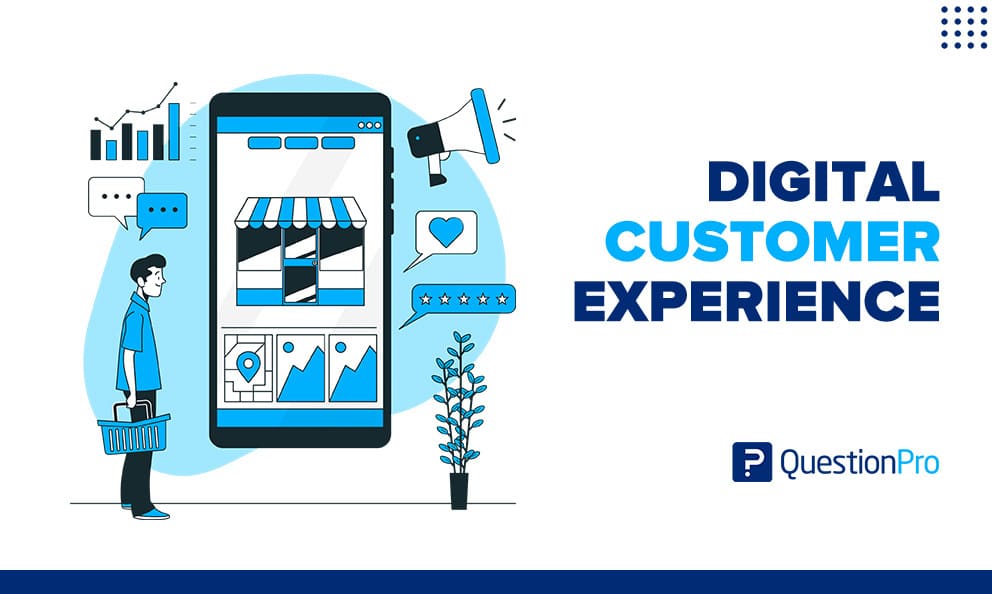 Reading Time: 3 minutes read
Reading Time: 3 minutes readIt is critical to understand your digital touchpoints and how they impact customer perception and brand loyalty. According to a recent survey, more than 65 percent of customers responded that their experience on the website or app would be an important factor in their proclivity to refer to a company. Let’s talk about digital customer experience.
What is Digital Customer Experience?
Digital customer experience is the component of your Customer Journey that deals with online platforms. Some examples are mobile and desktop and digitally-mediated experiences such as owned applications and social media content. It also covers digitally linked settings, such as IoT and voice-activated devices.
Finally, each interaction your customers have with your brand over the internet is a digital experience.
Stages of digital customer experience stages
You might argue (with some justification) that the digital world has given us as many stages of the buyer’s journey as there are grains of sand on the beach.
However, you’ll be relieved to know that three critical buying stages span every client experience — regardless of industry. Let’s have a peek…
1 – Knowledge: the period of discovery
When consumers understand they don’t have something and need something, they are in the discovery stage. This may be repairing a damaged refrigerator or purchasing a second bike that is more suited for riding to work.
And what about the user? They use the internet to conduct research. This implies that you must ensure that you are answering their inquiries as a brand. You are not yet selling to them, but you are addressing their questions, and they are beginning to believe you know what you are talking about.
Tutorials, blog pieces, and e-books will be the kind of material you develop for the customer awareness stage.
2 – Incorporate: the evaluation phase
After consulting with several sources to help them solve their problem, the consumer will begin to consider which solution is ideal for them.
To do so, they’ll evaluate their alternatives by reading purchasing guides, reviewing customer reviews, and watching product videos to determine which option is best for their customer experience budget.
As a result, as a brand, you must ensure that you have this material on hand to help potential clients determine that you are their best alternative.
3 – Judgment: the period of selection
The final stage is the decision phase. Customers know exactly which product will satisfy their demands and must now pick from the available possibilities. As a brand, it’s time to make sure you have the correct content to illustrate your competitive edge.
Why not let the buyer decide for themselves with a free trial period if you can? This might go a long way toward removing any remaining hurdles, so be generous if you can!
Why should you examine your digital customer journey experience?
There are various advantages to digital customer journey mapping, including:
- Identify the friction sources that cause the client to change, postpone, or cancel their project.
- Better awareness of client requirements and habits in order to provide them with the most appropriate material at the most appropriate moment.
- Giving you information to help you focus your marketing efforts on the most profitable or high-potential possibilities.
According to our studies, three key components of a great digital customer experience exist:
- Success – did the consumer complete their work and reach their goal?
- Effort – Was the procedure basic and straightforward?
- Emotion – Did they feel happy after the interaction?
The third is the most effective, but why?
Creating brand experiences based on human emotions and expectations allows you to engage with your consumers as individuals, not just clients. What do your consumers desire, a pleasant and organized environment? Do they want you to be more personal, or do they want you to keep your promises?
LEARN ABOUT: Consumer Decision Journey
Conclusion
Today’s companies must obsess about knowing and connecting with customers based on what they anticipate. During these increasingly competitive times, this characteristic is what keeps consumers coming back for more and even lobbying for you.
Working with our leading clients has shown us that businesses that build experiences that connect on a human level become industry leaders. Everything we’ve spoken about so far is a recipe for creating both consistent achievement and deeply connecting connections with the people who matter the most.
Making an emotional connection with clients might be challenging, but it is well worth the effort. So, start by learning what excites and frustrates your consumers, effectively sharing your findings with customers and workers to drive change, and don’t be afraid to do things differently to harness the power of human emotion and customer experience.
With QuestionPro, you can capture your customers’ journey at various touchpoints and gain real-time insights. Share feedback with different teams to improve the overall customer experience.
Get started with your 10-day CX trial
Author: Shoaib Sayyed




















